
Agave americana, commonly known as the century plant, maguey, or American aloe, is a flowering plant species belonging to the family Asparagaceae. It is native to Mexico and the United States, specifically Texas. This plant is widely cultivated worldwide for its ornamental value and has become naturalized in various regions, including Southern California, the West Indies, South America, the Mediterranean Basin, Africa, the Canary Islands, India, China, Thailand, and Australia.
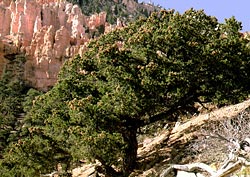
Pinus edulis, the Colorado pinyon, two-needle piñon, pinyon pine, or simply piñon, is a pine in the pinyon pine group whose ancestor was a member of the Madro-Tertiary Geoflora and is native to the United States.

Sotol is a distilled spirit from the Chihuahuan desert sourced from the plants of the genus Dasylirion, most commonly: Dasylirion wheeleri, Dasylirion durangense,Dasylirion cedrosanum, and Dasylirion leiophyllum, less commonly with Dasylirion texanum and Dasylirion lucidum, plants that grow in the Chihuahuan desert of northern Mexico, New Mexico, Arizona, and west and central Texas. Sotol liquor is known as the state spirit of Chihuahua, however, the drink is also consumed in Durango and Coahuila. Sotol has its own appellation of origin since 2002, and may be produced only in Chihuahua, Coahuila and Durango. There are dozens of commercial examples available. Production of sotol spirits exists outside the Sotol Denomination of Origin in several regions such as Sonora where it is known as Palmilla, Oaxaca (Cucharillo), and the Texas Hill Country.

Dasylirion wheeleri is a species of flowering plant in the asparagus family (Asparagaceae), native to arid environments of northern Mexico and the southwestern United States.

The JC Raulston Arboretum is a 10-acre (40,000 m2) arboretum and botanical garden administered by North Carolina State University, and located in Raleigh, North Carolina. It is open daily to the public without charge.

Abies religiosa, the oyamel fir or sacred fir, is a fir native to the mountains of central and southern Mexico and western Guatemala. It grows at high altitudes of 2,100–4,100 metres (6,900–13,500 ft) in cloud forests with cool, humid summers and dry winters in most of its habitat regime. In the state of Veracruz, it grows with precipitation all year long. The tree is resistant to regular winter snowfalls.
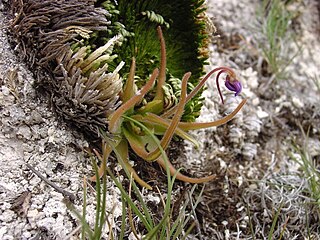
Pinguicula gypsicola is an insectivorous plant of the genus Pinguicula native to the Mexican state of San Luis Potosi, a heterophyllous member of the section Orcheosanthus. It grows in gypsum soils and forms stemless rosettes of upright, narrow leaves.

Agave mitis is a plant species native to the Mexican states of Hidalgo, Tamaulipas and San Luis Potosí, referred to as Agave celsii in many publications.

Agave shawii is a species of monocarpic succulent plant in the genus Agave, commonly known as Shaw's agave. It is a rosette-forming plant characterized by glossy, green leaves with toothed margins. After several years of slow growth, the plant puts all of its resources to produce a towering stalk of flowers, and then dies. The death of the flowering rosette is compensated by the growth of numerous clonal pups. This species is segregated into two subspecies, one native to the coast of southwestern California and northwestern Baja California, known commonly as the coast agave, and another native to the Baja California Desert, known as the Goldman agave.

Dasylirion acrotrichum, the great desert spoon and green sotol, is a plant native to the Chihuahuan Desert and other xeric habitats in northern and central Mexico.

Agave salmiana is a species of the family Asparagaceae, native to central and southern Mexico. It is also reportedly naturalized in South Africa, Italy and Spain, specially in the Canary Islands.

Agave is a genus of monocots native to the hot and arid regions of the Americas and the Caribbean, although some Agave species are also native to tropical areas of North America, such as Mexico. The genus is primarily known for its succulent and xerophytic species that typically form large rosettes of strong, fleshy leaves. Agave now includes species formerly placed in a number of other genera, such as Manfreda, ×Mangave, Polianthes and Prochnyanthes.

Agave murpheyi is a species of agave. It is a succulent plant that is found growing only at a few dozen archaeological sites of the ancient Hohokam Indians in southern Arizona and northern Sonora, Mexico. In 1935 there were reported half a dozen sites and in 1970 only two were known. It appears to be a cultivar grown by the Hohokam for food and fiber. Its common names include Hohokam agave, Murphey agave, and Murphey's century plant.
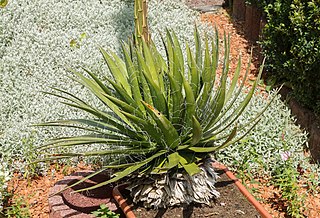
Agave filifera, the thread agave, is a species of flowering plant in the family Asparagaceae, native to Central Mexico from Querétaro to Mexico State. It is a small or medium-sized succulent plant that forms stemless rosette up to 3 feet (91 cm) across and up to 2 feet (61 cm) tall. The leaves are dark green to a bronzish-green in color and have very ornamental white bud imprints. The flower stalk is up to 11.5 feet (3.5 m) tall and is densely loaded with yellowish-green to dark purple flowers up to 2 inches (5.1 cm) long. Flowers appear in autumn and winter.

Agave guadalajarana is a smallish Agave species endemic to Mexico. It is native to the Guadalajara region of Jalisco state, and the Ceboruco volcano area of Nayarit state.
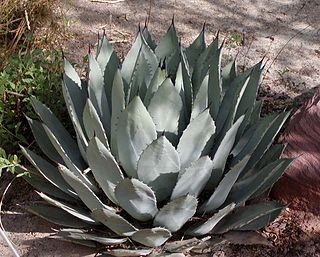
Agave palmeri is an especially large member of the genus Agave, in the family Asparagaceae.

Agave striata is a plant species native to Northeastern Mexico. Because the species is widespread and does not appear to be under any significant threats, it is not considered by the IUCN to be threatened.

Yucca jaliscensis is a Yucca species native to the highlands of southwestern Mexico. Common names for this species include Jalisco Yucca, Jalisco Soapwort, Izote Yucca. It is native to mountainous areas at about 5000 feet in the States of Jalisco, Colima and Guanajuato.
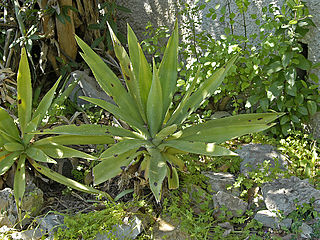
Agave decipiens, common names false Sisal or Florida agave, is a plant species endemic to coastal Florida in the United States.
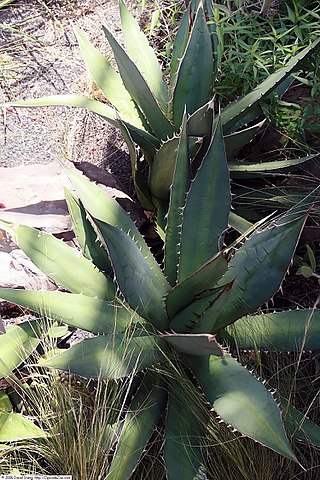
Agave titanota, the chalk agave, is a species of flowering plant in the family Asparagaceae. It is a medium-sized evergreen succulent perennial native to Oaxaca, Mexico. It often reaches 1-2 feet tall and 2-3 feet wide.




















